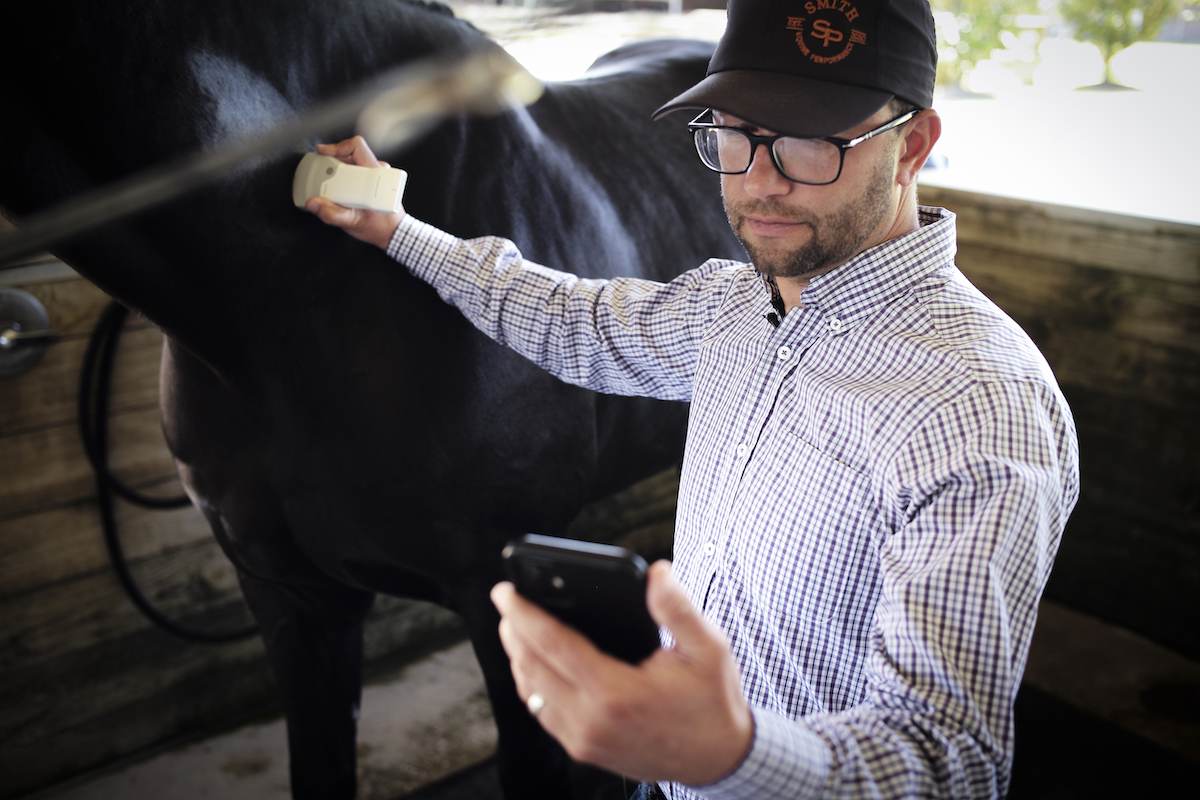Performing an ultrasound is one thing when you’re in a sterile exam room with multiple power outlets, high-resolution monitors, and adjustable lighting. It’s entirely different when you’re in a dimly lit barn with no electricity and you’re trying to maneuver your way around a horse who very well may mistake an electrical cable for a snake.
These are standard working conditions, however, for Dr. Clayton Smith, an equine veterinarian in Magnolia Station, Texas, just outside Houston. So when he heard about GE HealthCare’s wireless handheld ultrasound system, the Vscan Air, at a veterinary conference, he immediately saw its potential.
“It’s nice and clean and neat,” Smith says. “There are no cords going everywhere. Staying safe and aseptic are easier. There are no moving parts. It makes it very easy for me, and it makes it safe for the animal.”
Traditional wired console ultrasound systems can be big and bulky, and need to be plugged in. They’re also relatively noisy, which can spook an animal. When Smith used these systems in the past, he would have to sedate his equine patients in advance, which would take a lot of extra time.
Now, with the Vscan Air, he can hold a probe in one hand — the probe, he says, is about the size of a hot dog bun — while the other is free to soothe the horse or hold a needle for a guided injection. The scanner connects to his iPad through Bluetooth, and the images show up instantly, which is handy in a triage situation when he just needs to get a quick picture of what’s going on with the patient, like whether there’s a musculoskeletal issue in the tendons or joints or a buildup of fluid in the lungs or the abdomen. Quick imaging means he’s able to make quick decisions.
“The portability is a huge factor,” Smith says. “I don’t get to work in a nice, clean exam room every day. In some of the places we work, there’s not a power source that’s easy to get to. A battery-operated system is very useful.”
GE HealthCare introduced the first pocket-size Vscan device for human use in 2010 — the Vscan Air is the fourth generation — but now, in a collaboration with Sound Technologies, the global veterinary imaging leader, it’s planning wider distribution in the U.S. to veterinarians like Smith. The Vscan Air is waterproof and durable (it has been tested to military drop standards), compatible with both iOS and Android systems, and works just as well with a house cat in a clinic as it does with a horse in a barn. The battery lasts for 50 minutes and can fully recharge in 75. It’s also more affordable than other veterinary scanning systems, which was a major point in its favor for Smith when he was deciding whether to purchase one.
“The ‘fits in your back pocket’ dual-probe design, simplified workflow, and unparalleled image quality makes the Vscan Air incredibly useful in any veterinary practice setting: mobile or in-clinic, standalone or as an adjunct to a larger specialized system,” says Tom Jacobi, president of Sound Technologies, “I am confident that our veterinary users will embrace the Vscan Air as the go-to choice for treatment-area and mobile-use scanning applications for dogs, cats, horses, cows, pigs, goats, and exotic animals including small mammals and reptiles.”
The Vscan Air does have its limits, though, says Smith. It doesn’t work as well if there’s a lot of fur in the way (a more common problem with animals than with humans). And while it produces excellent images of things closer to the surface, it doesn’t do as well rendering deep tissue images, like ligaments embedded deeper in the skin or joints covered with muscle mass. For those Smith still has to use a heavier but more powerful console ultrasound.
“It improves my workflow,” he says. “I don’t have to go to my truck to grab tranquilizing equipment and then wait for the horse to get into proper tranquilization. Using the Vscan is no different from putting a hand on them. There aren’t a bunch of cords dragging around. I can do exams I don’t usually do with a wired system.”

